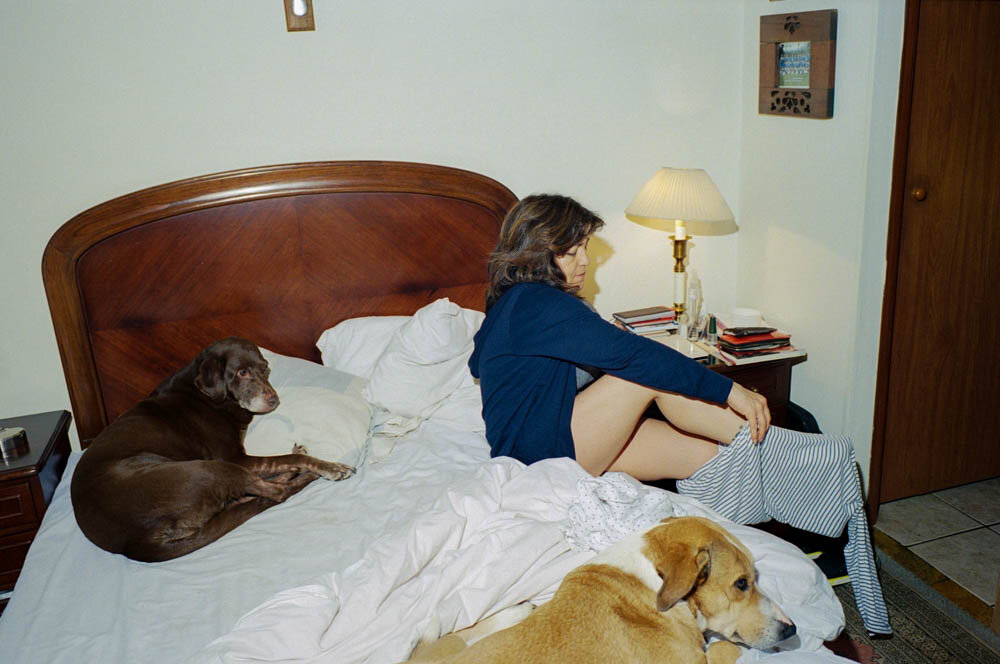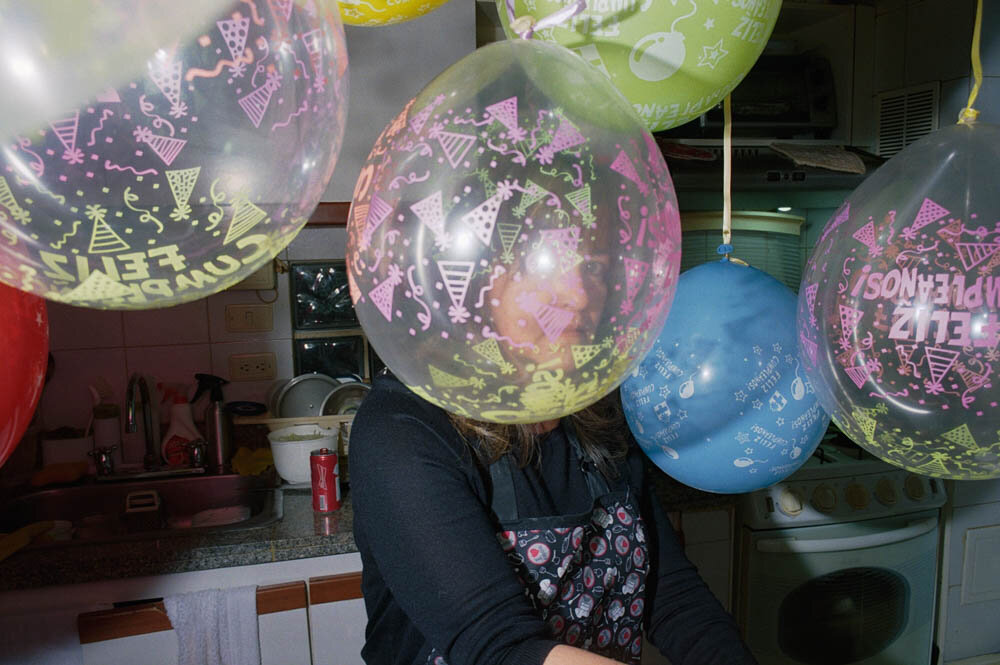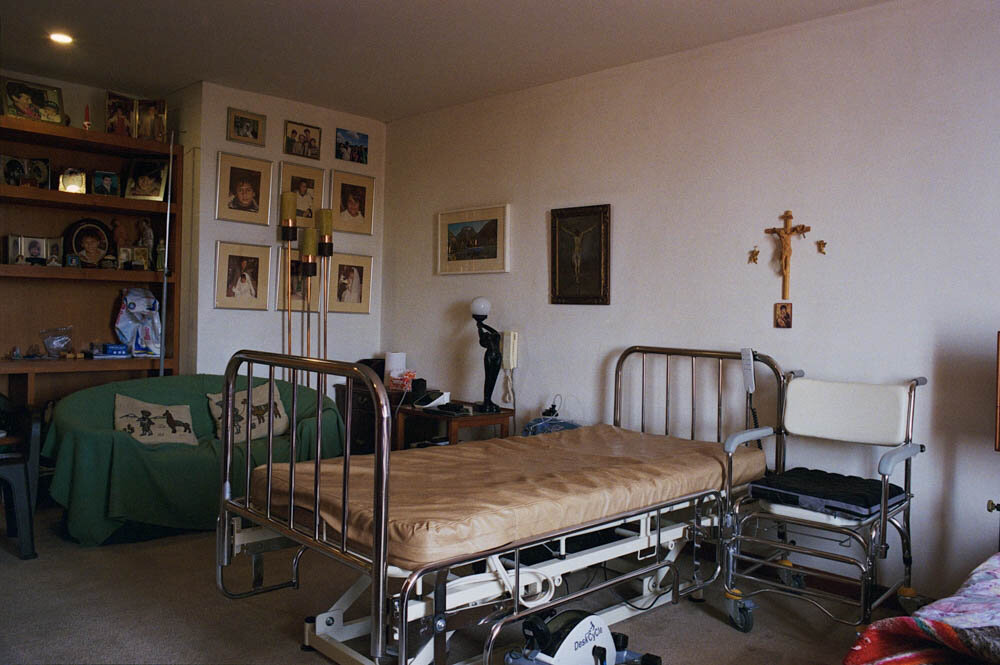Andres Rios
Andres Rios (b.1995) is a self-taught street photographer from Bogota, Colombia. Much of his work spans between Bogota and New York City where he can be found roaming the streets with a Leica M6 and pockets full of Ultra Max. Shooting all analog, his work captures everything from romantic connections on corners to quirky, dark scenes from city sidewalks. Starting March 2020, Andres had been quarantined with his mother in Bogota; a city that had very strict guidelines about leaving one's home.
For a photographer who was used to shooting strangers everyday on the street; this meant immersing himself in a new daily process of being isolated at home. Andres’ work shifted from shooting quirky strangers in public spaces to turning his camera towards his family for the first time. Eventually when he was able to see his grandparents and father he continued to document all the in between moments of life during a pandemic; right up until the moment his grandpa passed away from covid on August 16th.
Andres' work from public to private spaces still hold the same tenderness and rawness that he captures on the street. We had the chance to ask him a few questions about shooting during quarantine and photography post-pandemic.
Visit Andres Rios’s Instagram to see more of his work.
“Cuarentena” by Andres Rios
“Cuarentena” by Andres Rios
Interview by Lauren Roche
When did you first get into photography?
I got into photography in 2016, the first time I arrived in NYC. The city stimulated me a lot visually; it was practically a natural reaction.
“Cuarentena” by Andres Rios
“Cuarentena” by Andres Rios
As a street photographer, what were some of the challenges of being in quarantine?
At the beginning it was a hard process. I was used to being outside shooting every day. I didn't like the first images that I shot at home, but I always believe that if I want to take good photographs I shouldn't be scared of taking bad images. The photographs that I categorize as "bad" ones are the ones that taught me in a way. After failing, I find out the pictures that I like, and then I fail again. It's a process that never ends. This is how I started to find a way to photograph at my place.
“Cuarentena” by Andres Rios
“Cuarentena” by Andres Rios
“Cuarentena” by Andres Rios
You initially started photographing only your mother when you were in quarantine. What inspired you to photograph her and your three dogs during quarantine?
I've always been curious about things I perceive visually. At the time I realized I wouldn't be able to shoot outside on the street like I used to. I tried to satisfy the curiosity by taking pictures of my surroundings at home; in this case it was my mom and my dogs. Also, I became interested in documenting everything that was inside our home after I saw my mom doing different things that were out of her daily routine.
“Cuarentena” by Andres Rios
“Cuarentena” by Andres Rios
Many of the images of your mother are so personal and intimate; for example the photo of her shaving her legs. What was that process like?
Being able to access these intimate spaces was a beautiful process for both of us.
My mom didn’t really like being photographed; she was very insecure about her physical appearance. I started to take photos of her that I thought she would like (like her sleeping with the dogs). Pictures that would help me show her how beautiful she is.
For her, being able to see herself in these pictures helped her recover that self-confidence, and for me, it just opened the doors to more intimate moments.
“Cuarentena” by Andres Rios
“Cuarentena” by Andres Rios
“Cuarentena” by Andres Rios
“Cuarentena” by Andres Rios
Eventually you were allowed to leave your home and you started to photograph your grandparents and father during quarantine. Can you tell us more about that process? Was it similar to shooting your mother?
When I started to review the photos I took of my mom, I was curious about what I could find at my grandparent's place. I wanted to portray their daily routine and see if something changed in their routine ( like my mom).
I became fascinated by the fact that my grandparents, dad, and my grandparent's nurse were staying at the same place. I knew that I would have the opportunity to capture different scenarios just because there were more people around. In the end, the process was the same; I had to earn my family's trust and make them comfortable with me hanging around with the camera all the time.
“Cuarentena” by Andres Rios
“Cuarentena” by Andres Rios
Overtime you started to shoot self-portraits alongside your family that felt so natural and raw (for instance the image of you in bed next to your grandma). How did these photos come about and what inspired you to start including yourself within the frame?
When my grandfather passed away, I started sharing more time with my grandma ( just the two of us). It was a time of sorrow. My inspiration always comes from asking myself “ how will this look in a picture?” I wanted to capture how I felt and how the situation was affecting me. Every time I was alone with my grandma I set up the camera and tripod. I had a shutter release cable on hand just in case something interesting happened.
“Cuarentena” by Andres Rios
“Cuarentena” by Andres Rios
You took a self-portrait of yourself while getting the covid test. Can you tell us more about this image and what inspired you to take it? How was it photographing while getting the test done because I know it is quite painful
Knowing that there was a possibility that my family and I could have been infected with COVID caused me a lot of stress and anxiety; especially for my grandparents. However, photography has always been my best companion in moments like these. If I only focus on taking photos it's easier for me to overcome those moments of tension.
When I had the chance to get the test I remembered a self-portrait taken by Lee Friedlander in a hospital and I wanted to try to take one of myself. I wasn't sure if it was going to work well, but I just had to try it. This is an example of when I say it's good to shoot even "bad pictures". You never know if it's going to work well or not, but it's always good to try. It's the minimum one can do.
Do you think after quarantine you will continue to shoot intimate photos of your family? Is this something you want to continue?
I think so. Taking photos of them made me value their company and appreciate them more. It changed my perspective on them. In the end this is what I value the most.
“Cuarentena” by Andres Rios
“Cuarentena” by Andres Rios
“Cuarentena” by Andres Rios
“Cuarentena” by Andres Rios
Who are some of your inspirations in photography?
Mmm... I have a really long list of people who inspire me, but I have some photographers that have a special place for me: Helen Levitt, Garry Winogrand, Lee Friedlander, Eggleston, Alec Soth, Larry Sultan, Daniel Arnold and Andre D. Wagner. They are a constant source of inspiration for me.
Visit Andres Rios’s Instagram to see more of his work.
























